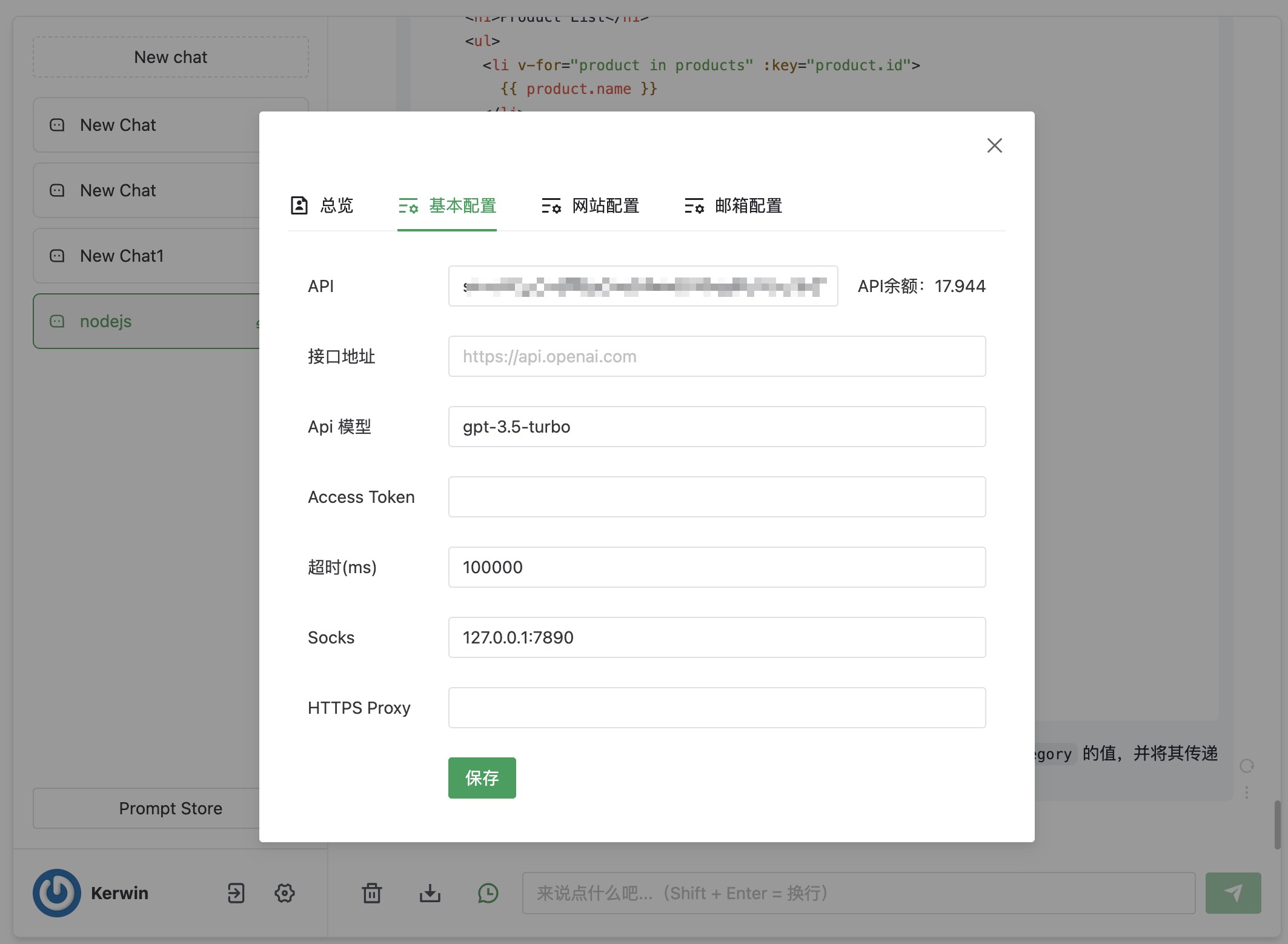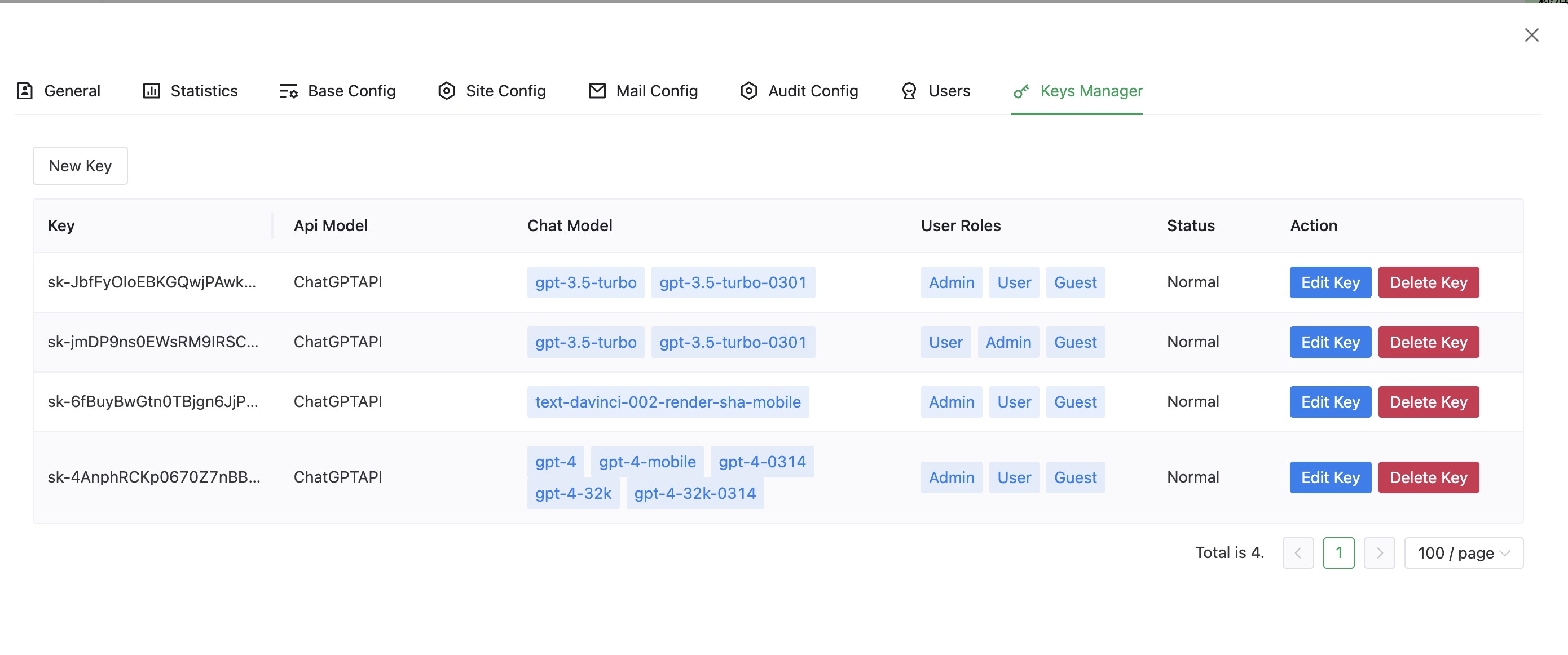# ChatGPT Web
## Introduction
> **This project is forked from [Chanzhaoyu/chatgpt-web](https://github.com/Chanzhaoyu/chatgpt-web), some unique features have been added:**
[✓] Register & Login & Reset Password
[✓] Sync chat history
[✓] Front-end page setting apikey
[✓] Custom Sensitive Words
[✓] Set unique prompts for each chat room
[✓] Users manager
[✓] Random Key
## Screenshots
> Disclaimer: This project is only released on GitHub, under the MIT License, free and for open-source learning purposes. There will be no account selling, paid services, discussion groups, or forums. Beware of fraud.







- [ChatGPT Web](#chatgpt-web)
- [Introduction](#introduction)
- [Roadmap](#roadmap)
- [Prerequisites](#prerequisites)
- [Node](#node)
- [PNPM](#pnpm)
- [Fill in the Keys](#fill-in-the-keys)
- [Install Dependencies](#install-dependencies)
- [Backend](#backend)
- [Frontend](#frontend)
- [Run in Test Environment](#run-in-test-environment)
- [Backend Service](#backend-service)
- [Frontend Webpage](#frontend-webpage)
- [Packaging](#packaging)
- [Using Docker](#using-docker)
- [Docker Parameter Example](#docker-parameter-example)
- [Docker Build \& Run](#docker-build--run)
- [Docker Compose](#docker-compose)
- [Deployment with Railway](#deployment-with-railway)
- [Railway Environment Variables](#railway-environment-variables)
- [Manual packaging](#manual-packaging)
- [Backend service](#backend-service-1)
- [Frontend webpage](#frontend-webpage-1)
- [Frequently Asked Questions](#frequently-asked-questions)
- [Contributing](#contributing)
- [Sponsorship](#sponsorship)
- [License](#license)
## Introduction
Supports dual models, provides two unofficial `ChatGPT API` methods:
| Method | Free? | Reliability | Quality |
| --------------------------------------------- | ------ | ----------- | ------- |
| `ChatGPTAPI(gpt-3.5-turbo-0301)` | No | Reliable | Relatively clumsy |
| `ChatGPTUnofficialProxyAPI(Web accessToken)` | Yes | Relatively unreliable | Smart |
Comparison:
1. `ChatGPTAPI` uses `gpt-3.5-turbo-0301` to simulate `ChatGPT` through the official `OpenAI` completion `API` (the most reliable method, but it is not free and does not use models specifically tuned for chat).
2. `ChatGPTUnofficialProxyAPI` accesses `ChatGPT`'s backend `API` via an unofficial proxy server to bypass `Cloudflare` (uses the real `ChatGPT`, is very lightweight, but depends on third-party servers and has rate limits).
[Details](https://github.com/Chanzhaoyu/chatgpt-web/issues/138)
Switching Methods:
1. Go to the `service/.env.example` file and copy the contents to the `service/.env` file.
2. For `OpenAI API Key`, fill in the `OPENAI_API_KEY` field [(Get apiKey)](https://platform.openai.com/overview).
3. For `Web API`, fill in the `OPENAI_ACCESS_TOKEN` field [(Get accessToken)](https://chat.openai.com/api/auth/session).
4. When both are present, `OpenAI API Key` takes precedence.
Reverse Proxy:
Available when using `ChatGPTUnofficialProxyAPI`.[Details](https://github.com/transitive-bullshit/chatgpt-api#reverse-proxy)
```shell
# service/.env
API_REVERSE_PROXY=
```
Environment Variables:
For all parameter variables, check [here](#docker-parameter-example) or see:
```
/service/.env
```
## Roadmap
[✓] Dual models
[✓] Multiple session storage and context logic
[✓] Formatting and beautifying code-like message types
[✓] Login or Register
[✓] Set API key and other information on the front-end page.
[✓] Data import and export
[✓] Save message to local image
[✓] Multilingual interface
[✓] Interface themes
[✗] More...
## Prerequisites
### Node
`node` requires version `^16 || ^18` (`node >= 14` requires installation of [fetch polyfill](https://github.com/developit/unfetch#usage-as-a-polyfill)), and multiple local `node` versions can be managed using [nvm](https://github.com/nvm-sh/nvm).
```shell
node -v
```
### PNPM
If you have not installed `pnpm` before:
```shell
npm install pnpm -g
```
### Fill in the Keys
Get `Openai Api Key` or `accessToken` and fill in the local environment variables [jump](#introduction)
```
# service/.env file
# OpenAI API Key - https://platform.openai.com/overview
OPENAI_API_KEY=
# change this to an `accessToken` extracted from the ChatGPT site's `https://chat.openai.com/api/auth/session` response
OPENAI_ACCESS_TOKEN=
```
## Install Dependencies
> To make it easier for `backend developers` to understand, we did not use the front-end `workspace` mode, but stored it in different folders. If you only need to do secondary development of the front-end page, delete the `service` folder.
### Backend
Enter the `/service` folder and run the following command
```shell
pnpm install
```
### Frontend
Run the following command in the root directory
```shell
pnpm bootstrap
```
## Run in Test Environment
### Backend Service
Enter the `/service` folder and run the following command
```shell
pnpm start
```
### Frontend Webpage
Run the following command in the root directory
```shell
pnpm dev
```
## Packaging
### Using Docker
#### Docker Parameter Example
- `OPENAI_API_KEY` one of two
- `OPENAI_ACCESS_TOKEN` one of two, `OPENAI_API_KEY` takes precedence when both are present
- `OPENAI_API_BASE_URL` optional, available when `OPENAI_API_KEY` is set
- `OPENAI_API_MODEL` `ChatGPTAPI` OR `ChatGPTUnofficialProxyAPI`
- `API_REVERSE_PROXY` optional, available when `OPENAI_ACCESS_TOKEN` is set [Reference](#introduction)
- `AUTH_SECRET_KEY` Access Password,optional
- `TIMEOUT_MS` timeout, in milliseconds, optional
- `SOCKS_PROXY_HOST` optional, effective with SOCKS_PROXY_PORT
- `SOCKS_PROXY_PORT` optional, effective with SOCKS_PROXY_HOST
- `SOCKS_PROXY_USERNAME` optional, effective with SOCKS_PROXY_HOST and SOCKS_PROXY_PORT
- `SOCKS_PROXY_PASSWORD` optional, effective with SOCKS_PROXY_HOST and SOCKS_PROXY_PORT
- `HTTPS_PROXY` optional, support http,https, socks5

#### Docker Build & Run
```bash
docker build -t chatgpt-web .
# foreground operation
docker run --name chatgpt-web --rm -it -p 127.0.0.1:3002:3002 --env OPENAI_API_KEY=your_api_key chatgpt-web
# background operation
docker run --name chatgpt-web -d -p 127.0.0.1:3002:3002 --env OPENAI_API_KEY=your_api_key chatgpt-web
# running address
http://localhost:3002/
```
#### Docker Compose
[Hub Address](https://hub.docker.com/repository/docker/kerwin1202/chatgpt-web/general)
```yml
version: '3'
services:
app:
image: kerwin1202/chatgpt-web # always use latest, pull the tag image again when updating
container_name: chatgptweb
restart: unless-stopped
ports:
- 3002:3002
depends_on:
- database
environment:
TZ: Asia/Shanghai
# one of two
OPENAI_API_KEY: xxxxxx
# one of two
OPENAI_ACCESS_TOKEN: xxxxxx
# api interface url, optional, available when OPENAI_API_KEY is set
OPENAI_API_BASE_URL: xxxx
# ChatGPTAPI 或者 ChatGPTUnofficialProxyAPI
OPENAI_API_MODEL: xxxx
# reverse proxy, optional
API_REVERSE_PROXY: xxx
# timeout, in milliseconds, optional
TIMEOUT_MS: 600000
# socks proxy, optional, effective with SOCKS_PROXY_PORT
SOCKS_PROXY_HOST: xxxx
# socks proxy port, optional, effective with SOCKS_PROXY_HOST
SOCKS_PROXY_PORT: xxxx
# socks proxy, optional, effective with SOCKS_PROXY_HOST and SOCKS_PROXY_PORT
SOCKS_PROXY_USERNAME: xxxx
# socks proxy port, optional, effective with SOCKS_PROXY_HOST and SOCKS_PROXY_PORT
SOCKS_PROXY_PASSWORD: xxxx
# HTTPS Proxy,optional, support http, https, socks5
HTTPS_PROXY: http://xxx:7890
# Title for site
SITE_TITLE: ChatGpt Web
# access salt,optional Allow login if not empty.
AUTH_SECRET_KEY: xxx
# mongodb's connection string
MONGODB_URL: 'mongodb://chatgpt:xxxx@database:27017'
# Register enabled
REGISTER_ENABLED: true
# After register enabled, Allowed mailbox suffixes for website registration. If empty, any suffix is allowed
REGISTER_MAILS: '@qq.com,@sina.com,@163.com'
# After register enabled, Salt for password encryption
PASSWORD_MD5_SALT: xxx
# After register enabled, super administrator
ROOT_USER: me@example.com
# After register enabled, The website's domain ending without /
SITE_DOMAIN: http://127.0.0.1:3002
# After register enabled, The smtp settings
SMTP_HOST: smtp.exmail.qq.com
SMTP_PORT: 465
SMTP_TSL: true
SMTP_USERNAME: noreply@examile.com
SMTP_PASSWORD: xxx
# Enable sensitive word review, because the response result is streaming, so there is currently no review.
AUDIT_ENABLED: false
# https://ai.baidu.com/ai-doc/ANTIPORN/Vk3h6xaga
AUDIT_PROVIDER: baidu
AUDIT_API_KEY: xxx
AUDIT_API_SECRET: xxx
AUDIT_TEXT_LABEL: xxx
links:
- database
database:
image: mongo
container_name: chatgptweb-database
restart: unless-stopped
ports:
- '27017:27017'
expose:
- '27017'
volumes:
- mongodb:/data/db
environment:
MONGO_INITDB_ROOT_USERNAME: chatgpt
MONGO_INITDB_ROOT_PASSWORD: xxxx
MONGO_INITDB_DATABASE: chatgpt
volumes:
mongodb: {}
```
The `OPENAI_API_BASE_URL` is optional and only used when setting the `OPENAI_API_KEY`.
### Deployment with Railway
[](https://railway.app/new/template/yytmgc)
#### Railway Environment Variables
| Environment Variable | Required | Description |
|------------------------|-------------------------------------------------------------------|------------------------------------------------------------------------------------------------------------------|
| `PORT` | Required | Default: `3002` |
| `AUTH_SECRET_KEY` | Optional | access password |
| `TIMEOUT_MS` | Optional | Timeout in milliseconds |
| `OPENAI_API_KEY` | Optional | Required for `OpenAI API`. `apiKey` can be obtained from [here](https://platform.openai.com/overview). |
| `OPENAI_ACCESS_TOKEN` | Optional | Required for `Web API`. `accessToken` can be obtained from [here](https://chat.openai.com/api/auth/session). |
| `OPENAI_API_BASE_URL` | Optional, only for `OpenAI API` | API endpoint. |
| `OPENAI_API_MODEL` | `ChatGPTAPI` OR `ChatGPTUnofficialProxyAPI` | API model. |
| `API_REVERSE_PROXY` | Optional, only for `Web API` | Reverse proxy address for `Web API`. [Details](https://github.com/transitive-bullshit/chatgpt-api#reverse-proxy) |
| `SOCKS_PROXY_HOST` | Optional, effective with `SOCKS_PROXY_PORT` | Socks proxy. |
| `SOCKS_PROXY_PORT` | Optional, effective with `SOCKS_PROXY_HOST` | Socks proxy port. |
| `SOCKS_PROXY_USERNAME` | Optional, effective with `SOCKS_PROXY_HOST` & `SOCKS_PROXY_PORT` | Socks proxy username. |
| `SOCKS_PROXY_PASSWORD` | Optional, effective with `SOCKS_PROXY_HOST` & `SOCKS_PROXY_PORT` | Socks proxy password. |
| `HTTPS_PROXY` | Optional | HTTPS Proxy. |
> Note: Changing environment variables in Railway will cause re-deployment.
### Manual packaging
#### Backend service
> If you don't need the `node` interface of this project, you can skip the following steps.
Copy the `service` folder to a server that has a `node` service environment.
```shell
# Install
pnpm install
# Build
pnpm build
# Run
pnpm prod
```
PS: You can also run `pnpm start` directly on the server without packaging.
#### Frontend webpage
1. Refer to the root directory `.env.example` file content to create `.env` file, modify `VITE_GLOB_API_URL` in `.env` at the root directory to your actual backend interface address.
2. Run the following command in the root directory and then copy the files in the `dist` folder to the root directory of your website service.
[Reference information](https://cn.vitejs.dev/guide/static-deploy.html#building-the-app)
```shell
pnpm build
```
## Frequently Asked Questions
Q: Why does Git always report an error when committing?
A: Because there is submission information verification, please follow the [Commit Guidelines](./CONTRIBUTING.en.md).
Q: Where to change the request interface if only the frontend page is used?
A: The `VITE_GLOB_API_URL` field in the `.env` file at the root directory.
Q: All red when saving the file?
A: For `vscode`, please install the recommended plug-in of the project or manually install the `Eslint` plug-in.
Q: Why doesn't the frontend have a typewriter effect?
A: One possible reason is that after Nginx reverse proxying, buffering is turned on, and Nginx will try to buffer a certain amount of data from the backend before sending it to the browser. Please try adding `proxy_buffering off;` after the reverse proxy parameter and then reloading Nginx. Other web server configurations are similar.
Q: The content returned is incomplete?
A: There is a length limit for the content returned by the API each time. You can modify the `VITE_GLOB_OPEN_LONG_REPLY` field in the `.env` file under the root directory, set it to `true`, and rebuild the front-end to enable the long reply feature, which can return the full content. It should be noted that using this feature may bring more API usage fees.
## Contributing
Please read the [Contributing Guidelines](./CONTRIBUTING.en.md) before contributing.
Thanks to all the contributors!
 ## Sponsorship
If you find this project helpful, please give me a star.
## License
MIT © [Kerwin1202](./license)
## Sponsorship
If you find this project helpful, please give me a star.
## License
MIT © [Kerwin1202](./license)